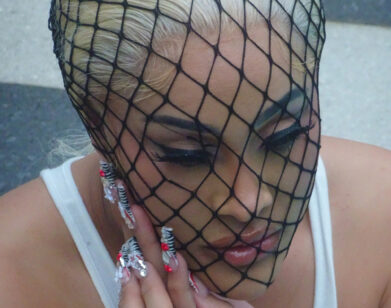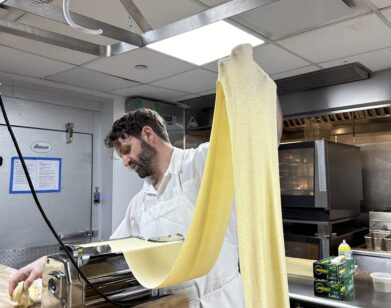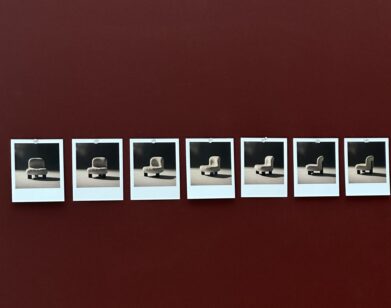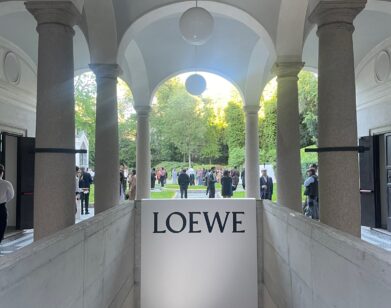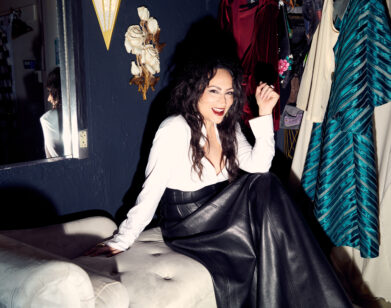The House of Von Macramé and the Horrors of Fashion
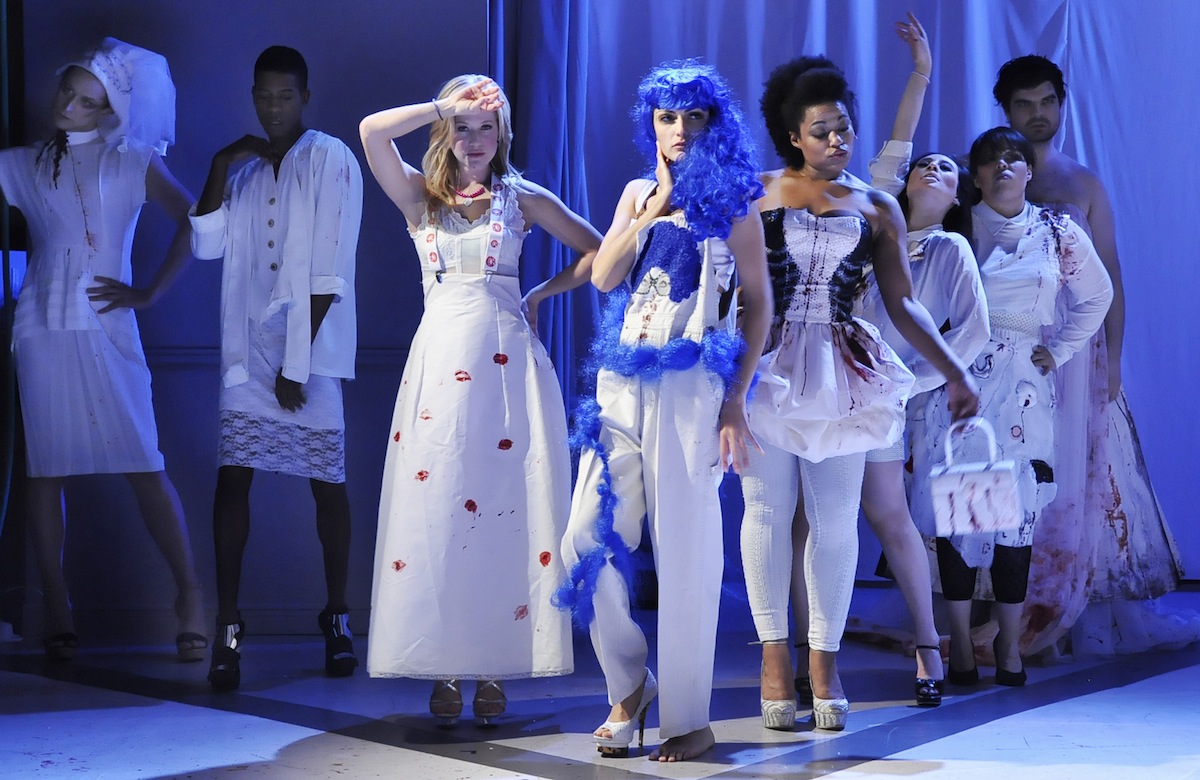
ABOVE: A SHOT FROM THE HOUSE OF VON MACRAMÉ. IMAGE COURTESY OF KATE HESS
Playwright Joshua Conkel doesn’t just want a new kind of theater—he wants a new kind of audience. “I want theater to be cool,” Conkel says wistfully, wearing a winter scarf and a sweatshirt with a cartoon hot dog on it. Unlike the over-the-top characters of his new play, The House of Von Macramé—a pop operetta that encompasses both runway shows and a camp horror-movie plot—Conkel is a sweet, smart creative who is slowly but surely getting what he wants. With a sold-out run at its theater, The Bushwick Starr, The House of Von Macramé may be next in line with the likes of The Rocky Horror Picture Show, Rent, or Hedwig and the Angry Inch to bring the stage a yet unexplored downtown creative subculture, set it to song, and catapult the tired theatrical experience into the realm of “cultural event.”
The House of Von Macramé started as a weekly serial at The Flea Theater in New York City, which went through a kind of “choose your own adventure”-style process of elimination. The audience would choose which 10-minute skit they liked best of the five presented by various writers, and the next week, the winners would have to turn out another episode for the next round of competition. Culling his cinematic references and pouring his pop-culture heart and New Wave lust onto the page, Conkel’s full-length version of the work is a blender full of Zoolander fashion parody, aesthetic and sonic nods to Dario Argento’s 1977 horror classic Suspiria, and a few solid references to that crazy Dior season that saw Courtney Love showing up to the Golden Globes in a dress made of trash bags. Anchoring the show with an intellectual undercurrent is its commentary on the fashion industry and gender, with songs such as “It’s Hard to be the Only Straight Guy in Fashion” and “Irrational Gay Hatred.”
We sat down with Conkel, his partner in crime, Megan Hill—who doubles as the show’s character Rosemary Crawley—to discuss what makes The House of Von Macramé a better time at the theater.
RYANN DONNELLY: What is The House of Von Macramé?
JOSHUA CONKEL: The House of Von Macramé is a pop horror fashion show modeled after these glamorous horror movies from the 1970s—specifically, the Italian sub-genre of giallo. It combines comedy, and fashion, and some extreme design aesthetics to make this evening of crazy theater.
DONNELLY: How is it different from traditional theater or musicals?
MEGAN HILL: I think we’ve approached it as being an event. For example, when the audience gets there, they’re immediately part of a step-and-repeat—they’re getting their picture taken like on a red carpet, they feel like they’re a part of this world. I think the music is so fun—great pop-synth, disco, doo-wop, New Wave; you want to dance. Then there’s the fashion element on top of that. There are three runway shows, so the audience is seeing these crazy fashions.
CONKEL: There are about 150 to 200 costumes—nobody is doing anything like that. We had to buy a washer and dryer for the theater. The other way I think it’s different is that the trend in American theater right now is toward naturalism, and quiet, intimate dramas. We’re doing the complete opposite of that. So, I think it’s refreshing for audiences to see something that’s a little more wild.
HILL: We’re pretty shamelessly lowbrow. We’re not trying to be pretentious. We want to push the form, make something different, and challenge the audience, but we don’t want to alienate anyone. We don’t want to make anyone feel stupid—we want to invite them in. But there is an overriding commentary about the fashion industry, the control it has, the relationship between gay men and women, and a lot about being an artist.
CONKEL: Also, I love fashion, and I love pop culture, and I want theater to be cool. I am so tired of plays that are dusty, and old Parisian pieces. I’m tired of square theater audiences. I want plays to feel more like rock shows, or fashion events, or fine art events, because I want a cooler, younger audience. And to get that, you have to make work that’s cool and young. All theaters want younger audiences, so what they’ll do is use an “edgier” font on their poster, and do the same old, dusty play instead of programming work that young, cool people want to see.
DONNELLY: What has influenced that approach?
CONKEL: Most of my influences are not theater—I love music, horror movies, fashion, comics—always mixing highbrow and lowbrow. In terms of my heroes that are theater artists—it’s a lot of tough, funny, gay men from the 1970s: Charles Ludlam, Charles Busch, Nicky Silver, Chris Durang.
HILL: Television from the 1980s. I also love Charles Busch, and viewpoints—Anne Bogart and Tina Landau. I think they’re really useful for kinesthetic awareness, and being aware of everything that’s happening around you.
DONNELLY: How long has the show been in the works?
CONKEL: It started as a late-night serial done in 10-minute increments at The Flea theater in Tribeca. Each week last summer, there would be five 10-minute plays presented, and the audience would vote on which ones they wanted to see return the following week. Mine lasted until I killed off all the characters. At that point, I already had the commission from The Bushwick Starr to turn it into a full-length musical, so I was using the serials as an opportunity to test ideas.
DONNELLY: How did you start working with the composer, Matt Marks?
CONKEL: I met him a few years ago through a mutual friend, and we just had really similar interests. I love disco, and New Wave, and very obscure horror movies. He liked all the same things, and had a very macabre sense of humor. Seemed like a match made in heaven.
HILL: You also had the same idea for a play.
CONKEL: Oh, yes! We both, separately, without knowing each other, wanted to write a musical about the Dating Game Killer! There was this serial killer in the 1970s that was on an episode of The Dating Game—like, mid-killing spree—and won. We ended up working on this instead, but it was such a weird, specific thing to be into.
DONNELLY: Can you talk about how your production company The Management works?
CONKEL: The Management started in 2004, and there are no original members. I started in the second season of the company.
HILL: I act as producer as well. I help raise money, I help sort logistical things—I’m always wearing two hats. Josh and I are heavy collaborators in that, I want to do everything he writes, and I’m lucky enough that he writes things for me.
CONKEL: We’re best friends, but we have a shared sensibility. We have the same sense of humor, we have an insane work ethic, and we’ll both basically do anything to ensure that our vision is what happens.
DONNELLY: How did you go about fund-raising?
HILL: We’re still raising money for it. We’re used to doing things on a shoestring budget. It’s still a small budget for a show of this size, but its about four times what our shows usually cost. We had a really successful IndieGogo campaign, had a couple independent producers that put in larger chunks of money, and we’re having a dance party!
DONNELLY: With so many influences outside of theater, what keeps drawing you back to it?
CONKEL: I understand the art of theater, just in my bones. And, even if I wanted to leave—and I have, and probably will again—there’s just nothing else for me to do. It’s my home—I grew up in the theater. And my desire to change theater has nothing to do with me hating it. I want to make it better.
FOR MORE ON THE HOUSE OF VON MACRAMÉ, VISIT ITS WEBSITE.


